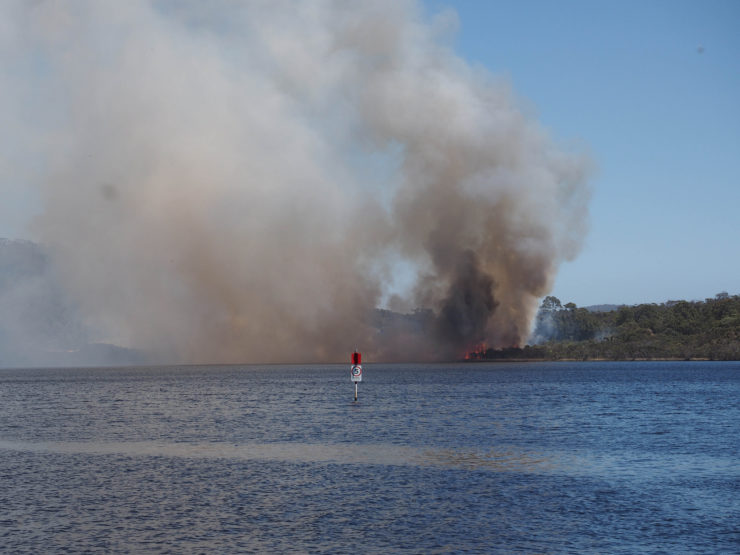Hiking safely in Australia’s bushfire season

Hiking safely in Australia’s bushfire season
Posted on
On Black Saturday, I awoke early and on hearing the weather reports, made the decision to call off my planned bushwalk. I’m not sure I’ve ever been as glad of any decision I’ve made in my life.
Since that day, I’ve been extra careful when planning hikes during bushfire season.
A 2016 study by the University of Tasmania found that the number of bushfires per week in Australia had increased 40 percent between 2008 and 2013. The Intergovernmental Panel on Climate Change predicted in 2007 that “the frequency of days when extreme fire danger threatens will increase by up to 25 percent by 2020, and up to 70 percent by 2050.
It’s clear that the danger is increasing for those of us who love the great outdoors, so what can we do to make sure we hike as safely as possible? Or in the worst-case scenario, what do we do if we find ourselves in the path of a bushfire?
Planning and preparation
Know when not to go
Obviously, the best way to stay safe is to not be out in the bush when bushfires are most likely to strike. On the hottest days in bushfire season, you might prefer to take a walk through an urban parkland or along the beach.
If you’re determined to go bush, you need to keep yourself informed about weather conditions and fire risks during the lead up to your trip and right up to the eleventh hour. You should never rely on someone else to tell you when to cancel your trip. Absorb all the information you possibly can and be willing to make that call yourself.
There are many sources of weather and bushfire information and you should never rely on just one source.
For bushfire information, you can check out the following:
- The website of your local fire authority (CFA in Victoria, RFS in New South Wales, etc.).
- Some state fire authorities will have bushfire information hotlines.
- Some state fire authorities will have smartphone apps.
- Your state park authority’s website or information line.
- Sky News.
- ABC local radio.
For weather information, see:
- The Bureau of Meteorology’s website.
- The Bureau of Meteorology’s weather app (available for Android and iOS).
- ABC local radio and Sky News are also good sources of weather info.
Plan ahead
It will help to be more familiar with your intended route than you’d perhaps normally be. Study maps of the area and make note of any possible shelter points, sources of running water and bodies of water, or patches of clear land. It’s always good to know about alternative access routes where you might be able to detour if necessary.
The more people in your group who are first aid trained, the better. You should particularly be aware of how to treat burns, shock, smoke inhalation, foreign objects in eyes, and heat stroke.
Get in touch with park authorities to confirm whether there’s likely to be water in any spots you find on the map and double check that alternate access routes aren’t closed.
Once you have that backup plan in place, ensure you leave full details of your trip including departure and expected return times with a trusted source at home.
What to bring
The gear you put in your backpack requires a bit of extra thought when there’s a risk of facing bushfires. Long sleeves and pants are essential if you want to protect yourself from radiant heat, as are sturdy shoes. Leather shoes and clothing made of natural fibres are the best option, as synthetic materials can melt and cause severe burns. If you have a lightweight woollen jumper, it’ll be an excellent addition. Some people even pack a fire blanket.
Carrying extra food and water is also a good idea, as there’s a chance you’ll need to spend extra days and nights away from civilisation.
A small battery-operated AM/FM radio will be handy to bring along if you have one. It’ll allow you to stay up to date on conditions once you hit the trail, where you’ll likely soon be away from mobile data reception.
If there was ever a time to bring along a PLB emergency beacon, bushfire season is the time. They’re quite affordable these days – you can hire one if you don’t want to buy one – and they exist for exactly the kind of worst case scenario you’re planning for.
During your walk
Once on the trail, stay alert for the smell of smoke and the sound of emergency vehicles, and keep your eyes peeled for the obvious signs of fire. You also need to pay particularly close attention to your navigation so that you’ll know your location at all times, in relation to the alternative escape routes and safety features you discovered when you studied the map before leaving.
Make a plan with your hiking group, agree on it, and be ready to put it into action. More on what your plan should include below.
If you meet other hikers along the trail or if you find yourself camped near others, it can be helpful to get to know them. You might all benefit from sharing your safety plans, and you’ll be able to keep an eye out for each other if there’s an emergency.
Hopefully, you’ll complete your hike without encountering any fires, but the next most important thing is to ensure you don’t start one. In Victoria, about 10 percent of bushfires in parks are started by campfires. Always extinguish campfires completely before leaving them or going to bed and be careful of any embers. Your fire isn’t safe to leave unless it’s cool to touch.
What to do if the danger becomes real
A good contingency plan should include what you’ll do if you get early warning signs like the smell of smoke or the distant sound of emergency vehicles.
The best option is always to retreat well before the flames are anywhere near you. Otherwise, there’s a chance you’ll make it back to the car only to find blocked access roads or dangerous driving conditions due to low visibility.
Most importantly though, you’ll need to plan for when the danger is more imminent.
There are three main dangers if the worst does happen – smoke and hot gases could asphyxiate you, radiant heat could be so intense it will burn you or cause heat stroke, and then, of course, there’s the actual flames. Your plan should consider all of these dangers.
No plan can take every possibility into account, but here’s a rough guide to what to do.
Start by calling 000 or setting off your PLB emergency beacon. You should cover yourself up with long sleeves and pants (and leather boots if you have them) and ditch any synthetic clothing. Try not to panic and calmly decide what to do next.
If you can see flames, you can then attempt to predict the fire’s behaviour. This will help you decide on your best course of action. Fires move more quickly uphill and burn more intensely in heavily forested areas. Open grassy spaces may be a safer place to be as the fire will burn with less intensity. However, keep in mind that the fire will move more quickly here. Unfortunately, if it’s a hot, dry, windy day, the fire will be less predictable.
Cover your mouth and nose with a wet cloth or item of clothing and try to move to a large area (the bigger, the better) that won’t burn. This could be a lake, dam, pond, creek or stream, a large rocky outcrop, a road or fire break, or a paddock if you’re near farmland. As a last resort, try to move towards areas of ground that have already been burnt. If possible, stay close to the ground as you move.
You may have no option but to attempt crossing through flames but if you do this, find the least intense looking flames, making sure you can clearly see behind them. They should be no more than a metre high and three metres deep.
Once you’re sure that you are in the safest possible place, clear the surrounding area of any combustible materials and then look for ways to protect yourself from radiant heat. Try to put something between you and the fire, such as a large rock, tree trunk or embankment, or find a depression in the ground. Lie down and cover yourself as much as possible, breathing into the ground to avoid the smoke. If you have water, keep drinking to hydrate yourself.
When the fire passes by you, move to already burnt ground (if you haven’t already) and commence first aid. If you have phone reception, notify authorities of your situation again and await rescue.
This kind of action plan applies to high-risk situations that don’t occur often. There’s no need to let fear creep in and put you off hiking altogether in bushfire season if you educate yourself on bushfire safety, plan ahead, and take all the necessary precautions.
Hike smart and stay safe.
-Neil Fahey
Guest Blogger



